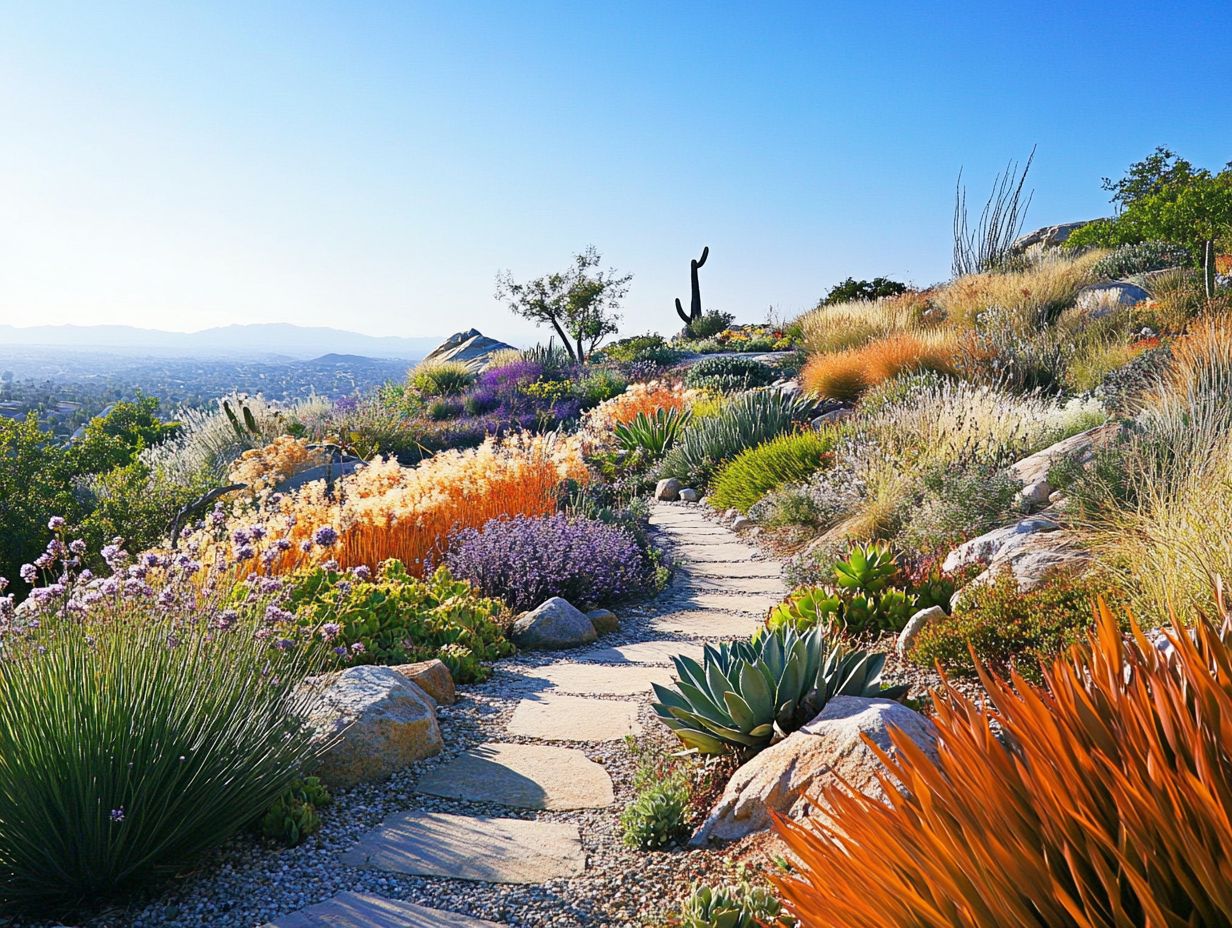Integrating Drought Plants into Landscapes
In a world increasingly confronted by climate change and water scarcity, understanding drought plants becomes paramount for crafting sustainable landscapes.
This article delves into what drought plants are, highlighting their myriad benefits and guiding you on how to seamlessly incorporate them into your garden.
From selecting native species to designing a drought-tolerant landscape, you ll be expertly navigated through the journey of creating an environmentally friendly space.
Explore alternative landscaping options like xeriscaping creating water-efficient gardens and hardscaping that flourish in dry climates. Transform your outdoor area while conserving precious water resources!
Contents
- Key Takeaways:
- Understanding Drought Plants
- Choosing the Right Drought Plants for Your Landscape
- Designing a Drought-Tolerant Landscape
- Alternative Landscaping Options for Dry Climates
- Frequently Asked Questions
- What are drought plants and why should I integrate them into my landscape?
- Can I use drought plants in any type of landscape?
- What are some examples of drought plants that I can use in my landscape?
- Are drought plants difficult to maintain?
- Are there any benefits to integrating drought plants into my landscape?
- How can I get started with integrating drought plants into my landscape?
Key Takeaways:

- Drought plants are water-efficient and beneficial for landscapes in dry climates due to their resilience and low maintenance needs.
- When choosing drought plants, consider native species and factors such as soil type, sun exposure, and water availability to ensure successful integration into the landscape.
- Incorporating drought plants and alternative landscaping methods, such as xeriscaping and hardscaping, can create visually appealing and sustainable landscapes in arid regions.
Understanding Drought Plants
Understanding drought-tolerant plants is crucial for landscaping, especially in areas grappling with climate change and limited water resources. By transforming your landscape for drought, you can incorporate strong plants, such as Arizona cacti and California succulents, that are uniquely suited to thrive in harsh conditions, offering both beauty and water conservation.
By embracing drought-tolerant landscaping techniques, you can craft outdoor spaces that conserve resources while enhancing local biodiversity. Exploring the aesthetics of drought-tolerant landscapes highlights how this thoughtful gardening approach benefits the environment and promotes sustainable practices that are economically sound.
What are Drought Plants?
Drought plants thrive in environments where water is scarce, showcasing deep-rooted systems and unique physiological traits that enhance moisture retention.
Consider the remarkable resilience of succulents and cacti; these plants boast specialized structures designed to minimize water loss while maximizing absorption, making them perfect for arid landscapes. By incorporating native plants into your landscaping, you support local ecosystems and promote biodiversity, all while requiring minimal irrigation.
Adopting xeriscaping principles like selecting appropriate drought-resistant specimens, utilizing mulch to retain soil moisture, and grouping plants with similar water needs allows you to significantly reduce water usage. This sustainable strategy conserves precious resources and cultivates resilient gardens that flourish even under the most challenging conditions.
Benefits of Using Drought Plants in Landscapes
Drought-tolerant plants supercharge your landscape with benefits like enhanced water conservation, reduced maintenance costs, and improved ecological resilience. For more insights, check out the benefits of drought-resistant landscaping, making them an excellent choice for the environmentally conscious gardener.
By incorporating drought-tolerant species, you can lower your water bills significantly, especially during dry spells, all while creating a visually stunning and inviting landscape. Consider using native plants in drought gardening; they not only bring beauty with their diverse textures and colors but also thrive in low-water conditions, promoting sustainability.
These plants create habitats for local pollinators and wildlife, enriching biodiversity in your garden. To truly maximize these advantages, consider implementing efficient irrigation strategies like drip systems or rainwater harvesting. This way, you ensure that water is used wisely, further supporting both your environmental and economic goals.
Choosing the Right Drought Plants for Your Landscape
Selecting the ideal drought-resistant plants for your landscape requires careful consideration of several key factors. You’ll want to assess your climate, manage your soil effectively, and understand the specific requirements of your outdoor space.
This approach enhances the beauty of your environment and promotes sustainability in harmony with nature.
Finding Native Drought Plants

Finding native drought-tolerant plants means exploring local flora that thrives in arid conditions. This ensures your landscaping looks stunning while supporting local biodiversity.
Utilize resources like local plant nurseries and online databases to find species resilient to low water. If you re in the Southwest, consider vibrant species like desert marigold or California poppy for a splash of color.
In the Midwest, coneflowers and black-eyed Susans are perfect for drier environments. Collaborating with local landscaping services that specialize in native plants can boost your efforts to promote biodiversity.
These professionals offer valuable knowledge and can help you create a sustainable garden that benefits the environment and local wildlife.
Factors to Consider in Plant Selection
When choosing drought-tolerant plants, consider key factors like water use and soil care practices. Understanding your local climate is essential; different regions affect plant performance.
The type of soil influences water retention and nutrient availability. Water access will determine which plants thrive in your area.
Techniques like drip irrigation, which delivers water directly to the roots, can significantly enhance water efficiency. Incorporating organic matter into the soil improves its structure and fertility, giving your plants the support they need.
By considering these factors, you can create a sustainable garden that flourishes even in the driest seasons.
Designing a Drought-Tolerant Landscape
Designing a drought-tolerant landscape involves crafting a cohesive plan that blends various elements. Consider incorporating efficient irrigation, strategic plant placement, and integrating wildlife habitats in drought gardens to enhance your design choices.
This method enhances the functionality and visual appeal of your outdoor spaces.
Creating a Plan for Incorporating Drought Plants
Start your plan by assessing your space’s unique conditions. This will guide you in selecting the right plants and implementing water-saving techniques.
Begin with a thorough site assessment. Evaluate factors like soil type, sunlight exposure, and wind patterns to determine which plants will thrive.
Once you understand these elements, choose native and drought-resistant species. This ensures your garden is beautiful and requires minimal irrigation.
Employ effective landscape design techniques, such as grouping plants with similar water needs and adding mulch. These strategies reduce evaporation and contribute to a sustainable ecosystem.
With thoughtful planning, your landscape will be eye-catching and resilient during water scarcity. Get started today!
Tips for Maintaining a Drought-Tolerant Landscape
Maintaining a drought-tolerant landscape demands ongoing attention. This includes:
- Applying organic mulch
- Establishing proper watering schedules
- Conducting regular assessments
These practices promote sustainability in your garden and elevate its visual appeal. Applying organic mulch is a game-changer! It retains moisture, reduces evaporation, and suppresses weeds that compete for essential resources. Adjusting watering schedules according to seasonal changes encourages deep root growth while minimizing water usage.
Regularly checking the condition of your plants, soil, and mulch allows you to tackle issues proactively. By implementing these strategies, you can cultivate a stunning space that thrives even under dry conditions.
Alternative Landscaping Options for Dry Climates

Explore alternative landscaping options tailored for dry climates, like xeriscaping and hardscaping. These innovative solutions help you craft beautiful and sustainable outdoor spaces that require minimal water and maintenance.
Embrace the beauty of your surroundings while being mindful of resource conservation.
Xeriscaping
Xeriscaping is a landscaping approach designed to use little or no water by utilizing drought-tolerant and native plants. It’s a superb choice for arid regions.
Focusing on plants that thrive in low-water environments promotes a more sustainable ecosystem. Key principles of xeriscaping include:
- Proper soil preparation
- Efficient irrigation techniques
- Strategic use of mulch to retain moisture
As you explore this strategy, consider incorporating native species that require minimal upkeep while still providing visual allure. The benefits of xeriscaping extend beyond water conservation; it can significantly reduce garden maintenance costs and enhance local biodiversity.
However, be prepared for challenges, such as the initial investment for redesigning your landscape and adjustments in gardening practices to accommodate these drought-resistant and deep-rooted plants.
Hardscaping with Drought-Tolerant Materials
Incorporating hardscaping with drought-tolerant materials provides a durable and visually appealing foundation for your landscaping. This allows you to reduce water usage while enhancing the charm of your outdoor spaces.
This approach champions environmental sustainability and opens the door to innovative design possibilities. Using materials like permeable pavers, natural stone, and gravel, you can create captivating patterns and textures throughout your landscape.
Adding features such as dry creek beds or raised beds introduces dimension while efficiently utilizing limited water resources. Positioning hardscaping elements alongside thoughtfully selected drought-resistant plants achieves a harmonious balance that showcases both structural beauty and vibrant greenery, creating a thriving outdoor oasis that is low-maintenance yet undeniably striking.
Frequently Asked Questions
What are drought plants and why should I integrate them into my landscape?
Drought plants are species adapted to thrive in dry conditions, making them ideal for landscapes with limited water availability. Using native plants in drought landscapes can help conserve water, reduce maintenance costs, and create a unique and resilient garden.
Can I use drought plants in any type of landscape?

Yes, drought-resistant plants can be incorporated into any landscape type, including residential gardens, public parks, and commercial spaces. Their diverse range of colors, shapes, and sizes makes them suitable for various design styles and purposes.
Start your drought-tolerant garden today!
What are some examples of drought plants that I can use in my landscape?
Some popular drought plants include lavender, succulents, yarrow, sage, and cacti. These plants can survive long periods without water and need little to no extra watering once established.
Are drought plants difficult to maintain?
No, drought plants are usually low maintenance. It s crucial to pick the right plant for the right spot to ensure success.
Proper watering, pruning, and fertilizing are key to keeping these plants healthy and thriving.
Are there any benefits to integrating drought plants into my landscape?
Yes! Incorporating drought plants has many advantages. They save water, attract pollinators, and provide habitats for wildlife, highlighting the future of drought-resistant landscaping.
Plus, they enhance your landscape s beauty with their unique textures and colors.
How can I get started with integrating drought plants into my landscape?
Begin by assessing your landscape to find the best areas for drought plants. Look at sunlight, soil type, and existing plants in those spots.
Next, research drought-tolerant plants suited for your conditions. Finally, plant and care for them properly to ensure they thrive in your landscape.






